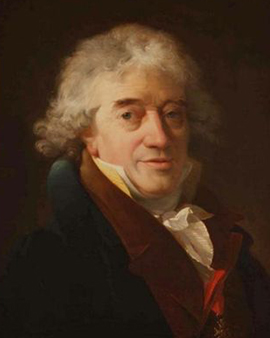


The Netherlands has a long tradition of flower painting, which was wonderfully continued and transferred to France through the work of Gerard van Spaendonck. Born in Tilburg on March 22, 1746 and died in Paris on May 11, 1822, Spaendonck left a legacy that secured his place in art history. His fine brushstrokes and masterful use of color, which we carefully reproduce in our fine art prints, give his works a unique depth and beauty.
Gerard van Spaendonck, also known as Gérard, Gerrit or Gerardus, followed in the footsteps of such greats as Jan van Huysum, Jan van Os and Rachel Ruysch. However, he was not only a follower, but also an innovator and teacher. His brother Cornelis van Spaendonck also became a well-known artist, perhaps inspired by Gerard's path. With the support of Claude Henri Watelet, Spaendonck was appointed miniature painter at the court of Louis XVI at the age of 28. In 1777 he held his first exhibition, and three years later he succeeded Françoise Basseporte as professor of flower painting at the Jardin des Plantes. He preferred to work in watercolor and was a master of the splash technique, in which fine dots are added to copperplate engraving to refine details and nuance colors.
Spaendonck's works are not only works of art, but also educational resources. He contributed more than fifty works to Les Vélins du Roi, an important collection of botanical watercolors owned by the French royal family. Between 1799 and 1801, he published a collection of 24 botanical engravings intended as high-quality study plates for budding flower painters. His contribution to education and culture was recognized when he was appointed an advisor to the Académie des Beaux-Arts in 1788 and a founding member of the Institut de France in 1795.
Posterity honored Spaendonck not only for his skills as a painter, but also for his abilities as an educator. Through his detailed and vivid flower paintings, reproduced as fine art prints, we can understand the unique style and technique of this master. He not only created stunning works, but also taught and inspired an entire generation of artists, including Pierre Joseph Redouté and Alexandre Paul Joseph Véron, to name a few. His works are more than just paintings - they are chapters in the history of art. Spaendonck died in Paris in 1822 and now rests in Père Lachaise Cemetery, but his legacy lives on in each of our art prints.

The Netherlands has a long tradition of flower painting, which was wonderfully continued and transferred to France through the work of Gerard van Spaendonck. Born in Tilburg on March 22, 1746 and died in Paris on May 11, 1822, Spaendonck left a legacy that secured his place in art history. His fine brushstrokes and masterful use of color, which we carefully reproduce in our fine art prints, give his works a unique depth and beauty.
Gerard van Spaendonck, also known as Gérard, Gerrit or Gerardus, followed in the footsteps of such greats as Jan van Huysum, Jan van Os and Rachel Ruysch. However, he was not only a follower, but also an innovator and teacher. His brother Cornelis van Spaendonck also became a well-known artist, perhaps inspired by Gerard's path. With the support of Claude Henri Watelet, Spaendonck was appointed miniature painter at the court of Louis XVI at the age of 28. In 1777 he held his first exhibition, and three years later he succeeded Françoise Basseporte as professor of flower painting at the Jardin des Plantes. He preferred to work in watercolor and was a master of the splash technique, in which fine dots are added to copperplate engraving to refine details and nuance colors.
Spaendonck's works are not only works of art, but also educational resources. He contributed more than fifty works to Les Vélins du Roi, an important collection of botanical watercolors owned by the French royal family. Between 1799 and 1801, he published a collection of 24 botanical engravings intended as high-quality study plates for budding flower painters. His contribution to education and culture was recognized when he was appointed an advisor to the Académie des Beaux-Arts in 1788 and a founding member of the Institut de France in 1795.
Posterity honored Spaendonck not only for his skills as a painter, but also for his abilities as an educator. Through his detailed and vivid flower paintings, reproduced as fine art prints, we can understand the unique style and technique of this master. He not only created stunning works, but also taught and inspired an entire generation of artists, including Pierre Joseph Redouté and Alexandre Paul Joseph Véron, to name a few. His works are more than just paintings - they are chapters in the history of art. Spaendonck died in Paris in 1822 and now rests in Père Lachaise Cemetery, but his legacy lives on in each of our art prints.
Page 1 / 1






